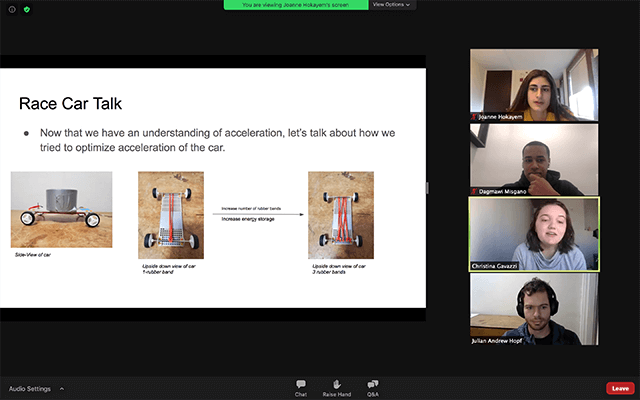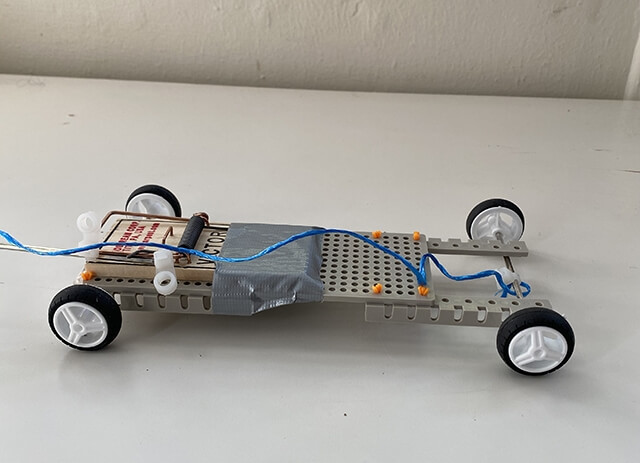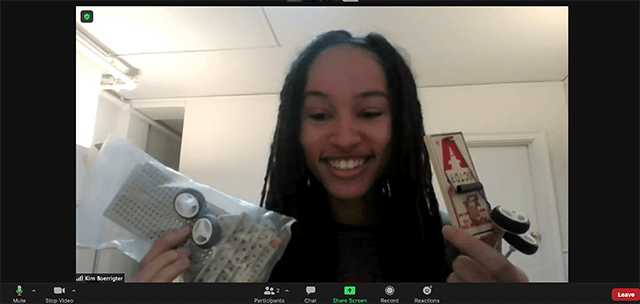News
A group of AP 50 students present the results of their first project.
When the students in Physics as a Foundation for Science and Engineering (AP 50) began presenting their first group projects via Zoom, they were doing more than demonstrating knowledge of kinematics—they were providing educational inspiration for high school teachers and students around the world.
Teams of AP 50 students were challenged to build self-propelled cars that exhibit physics concepts, like momentum or energy. But instead of competing in a drag race, as they’ve done in year’s past, teams used the cars to create inspirational and educational presentations aimed at high schoolers, or lesson plans teachers can use to remotely engage their students.
The idea grew out of an online National Science Foundation workshop hosted by Harvard University in July that was organized by AP 50 instructor Eric Mazur, Balkanski Professor of Physics and Applied Physics at the John A. Paulson School of Engineering and Applied Sciences.
“After talking with these high school teachers this summer, I realized they are struggling with how to keep students engaged and how to teach them in a hybrid or remote scenario,” Mazur said. “So I thought, let’s put this first project in the context of how the pandemic has disrupted secondary education. I told my students, we’re going to put our learning at the service of the public good by essentially having you give lessons to high schools.”
Dozens of teachers and hundreds of students from 23 high schools across the U.S. and in Mexico, Ecuador, Italy, and Turkey, logged on to watch—and judge—the student presentations. High school students and teachers rated teams based on how educational and engaging their presentations were.
For Aaron Shirley, A.B. ’23, and his teammates, the challenge of using their knowledge to teach younger students was not something they took lightly, especially since Shirley’s high school physics teacher, Dan Shomaker, was in the audience.
Aaron Shirley built this self-propelled car out of items he received in the AP 50 kit.
“We tried to really think about how we would explain kinematics to high school students,” Shirley said. “I had an awesome physics teacher, but I had a shaky math and science background. So I was focused on how I would teach students about science when I know, when I was in their position, everything didn’t always click for me.”
Before they began the project, students received a kit in the mail with parts and equipment, including twine, mouse traps, balloons, and rubber bands, to build a self-propelled car. Each team member built a car individually. Then the group collaborated to iterate on a final design that maximized a certain property, like acceleration or inertia.
Shirley and his teammates produced a rubber band-powered car that was specially designed to reduce friction on the wheels, which were oiled to maximize velocity, he explained.
He and his teammates walked through those design elements, and the science behind them, during their presentation.
"One of my main goals for AP 50 is to promote intrinsic motivation to learn—to give students a sense of ownership of their learning. One way to accomplish this is to add a component of empathy or social good to the projects, something we were already doing before the transition to remote teaching. This year, however, I started to frame the projects in the context of societal problems and the problems in education caused by pandemic seemed like the perfect context. One of the things I clearly saw this year, also, is that giving students more freedom in determining the details of their project leaves more room for creativity, which in turn promotes ownership of the project and enhances learning." - Eric Mazur, Balkanski Professor of Physics and Applied Physics
Shomaker, a physics teacher at Oscar Smith High School in Chesapeake, Va., used the virtual project fair as an opportunity to discuss problem-solving with his students. He appreciated the open-ended nature of the AP 50 project and may look to incorporate some aspects into future physics labs.
Beyond reinforcing physics concepts, the presentations served as inspiration for his students.
“My students really enjoyed seeing Harvard students up close and personal. Harvard has a reputation, and for the students I teach, many of them wouldn’t even dream of going there,” he said. “The presentations were top-notch, and my students enjoyed being able to dissect the concepts and understand what was going on. But there were a couple of mistakes in the presentations, and my students were able to pick out those mistakes. They saw that people do make mistakes, whether they go to Harvard or the local community college.”
Ada Verónica Chavarría Treviño and Rodolfo Fernández, instructors at PrepaTec Cumbres Monterrey in Monterrey, Mexico, decided to attend the project fair after seeing an invitation from Mazur on Twitter. It seemed like a golden opportunity to motivate students to engage in science, Treviño said.
“They saw some techniques that could help them improve their own experiments and have better control over their variables,” Fernández said. “It was great for them to see some new ideas about how to design an experiment with a practical application.”
The presentations also inspired Treviño and Fernández, who saw how providing an open-ended set of instructions pushed AP 50 students to exhibit more creativity and engagement with their projects.
“In high school, sometimes we are very concrete and concise with the process the students should follow,” Treviño said. “But the way that these students had the liberty to improve or make modifications using other items, to go beyond the kit they received, is very enriching for the learning experience.”
Kim Boerrigter displays some of the items she received in the AP 50 kit, which she used to build her self-propelled car.
For Kim Boerrigter, A.B. ’21, an integrative biology concentrator, AP 50 is the first physics course she’s taken and she was slightly intimidated when she received the kit in the mail—. But she quickly found she enjoyed tweaking her car and perfecting the final design.
The assignment impressed upon her how unforeseen changes impact a collaborative project, making it critical to be flexible and creative at every turn.
While she was apprehensive about teaching high schoolers concepts she had just learned, the exercise forced her to break them down into simpler terms that improved her own understanding.
“It has made physics a lot less scary for me, because it has allowed me to develop an appreciation for the math, the equations, and the calculations involved,” she said. “I do very much enjoy math as a subject on its own, with most of that enjoyment arising after I realized that there is no cookie-cutter way to teach or learn math, and that I am not inherently worse at it because I struggle to learn in more traditional ways, or because the inherent lack of resources available to me prior to college.”
She hopes the project made physics less scary for the high schoolers, too.
“I hope they were able to see that learning can still be cool and interactive and fun,” she said. “Even though everything in the context of learning is different and has been reformatted and turned on its head, don’t give up on classes. Don’t think that you’ll never learn anything. We have to change and adapt the way we teach students going forward, although a change has been long overdue.”
Cutting-edge science delivered direct to your inbox.
Join the Harvard SEAS mailing list.
Press Contact
Adam Zewe | 617-496-5878 | azewe@seas.harvard.edu





